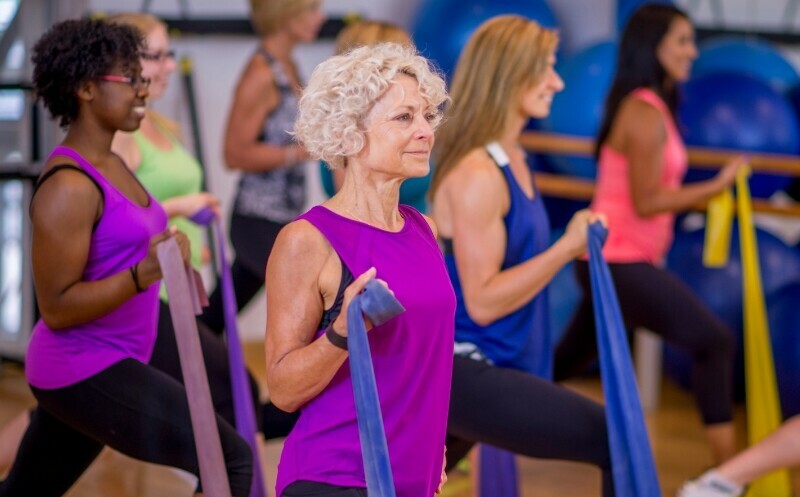Resistance bands: versatile and effective. These fitness bands are a simple way to unlock your fitness potential. They cater to diverse fitness levels and goals.
With their adaptable resistance levels and ability to target multiple muscle groups, they provide a platform for both strength training and rehabilitation.
Whether in the gym, at home, or on the go, resistance bands empower individuals to sculpt their bodies, improve flexibility, and enhance overall fitness levels. This makes them a compact and indispensable tool for low-impact fitness.
-Brief overview of resistance bands
I often hear from people who want to keep fit but struggle with either the space for equipment or the ability to take their workouts on the road. That’s where resistance bands come in.
These simple loops of elastic are deceptively powerful tools for transforming your fitness routine, no matter where you are.

-Their space-saving design is ideal for home workouts and travel fitness.
With resistance bands, working out at home and while traveling is simplified.
They fit easily in drawers or suitcases and provide a convenient option for exercise at home and while traveling. What an excellent solution for compact fitness opportunities!
Benefits of Low-Impact Workouts with Resistance Bands
Resistance bands are gentle on the joints. Unlike cumbersome gym machines, resistance bands promote a natural range of motion, which is crucial for building functional strength and fitness.
-Importance of low-impact exercises for long-term joint health
Resistance bands offer benefits in terms of reduced joint stress compared to traditional weights. This is particularly the case for individuals with joint pain or injuries.
If you worry about the strain that high-impact exercises can put on your joints, you’ll be glad to know that resistance bands are a game-changer.
They open the door to effective, joint-friendly workouts, because they provide resistance without the pounding impact of running or jumping.
They’re kind to your body while still pushing you to get stronger.

-Resistance bands contribute to improved balance and coordination.
Using resistance bands can lead to notable improvements in your balance and coordination.
When you perform exercises with these flexible bands, your body must engage stabilizing muscles that aren’t typically used in machine-based workouts.
Resistance bands activate muscles that help you maintain balance and avoid falls as you age.
Pull-Up Resistance bands for Men and Women – Physical therapy, Muscle training
VIECK Resistance Bands – 48” long with handles – Set of 5 – 10 lbs-150 lbs resistance. Mobile Gym to Build Muscles
Resistance Bands for working out – 4 Booty Bands with Workout Guide – Leg Bands for Working out Hips, Thighs, and Glutes

This post contains affiliate links. If you click on and purchase through one of those links, you won’t pay a penny more, but we’ll get a small commission, which helps keep our website operating. Thanks! As an Amazon Associate, I earn from qualifying purchases.
-Exercise with resistance bands to enhance range of motion.
Perhaps even more impressive is the way resistance bands can enhance your range of motion. By allowing you to move naturally and with control through various planes of movement, they can increase your joint flexibility and muscle elasticity.
Plus, you’ll find that everyday activities and motions become easier, as your limbs can move freely, without discomfort or restrictions.
-Rehabilitation
Resistance bands are often recommended for elderly individuals or those undergoing rehabilitation due to their low impact nature.
They can accommodate different levels of strength and mobility. No matter where you’re starting from, a reliable set of resistance bands can facilitate gradual progress in strength training. This makes them suitable not only for beginners but also as you get stronger.

Full-Body Workout with Resistance Bands
With resistance bands you can get a workout that hits every muscle group without turning your living room into a makeshift gym.
-Upper body exercises
Upper body exercises with resistance bands offer a versatile and effective way to target various muscle groups, including the chest, shoulders, back, and arms. Here’s a brief overview of how to perform upper body exercises with resistance bands:
Chest:
Perform chest presses by securing the resistance band behind you and pressing forward with both hands. For fly exercises, anchor the band and extend your arms outward in a controlled motion.
Shoulders:
Target the shoulders with exercises like lateral raises, front raises, and shoulder presses. Stand on the band with feet shoulder-width apart and lift the bands upward or outward.
Back:
Work the back muscles with exercises such as rows and lat pulldowns. Anchor the band at chest height and pull the bands toward you or down toward your hips.
Arms:
Strengthen the arms with bicep curls, tricep extensions, and shoulder rotations. Hold the bands with palms facing up or down and perform the respective movements against the resistance.
You can adjust band tension and positioning to suit your strength level and target specific areas of your upper body effectively.
And the good thing is there is no need for bulky equipment.

-Lower body exercises
Here’s a brief overview of how to perform lower body exercises with resistance bands:
You can strengthen your legs, hips, and glutes, and improve your lower body endurance and power. Squats, lunges, and leg presses are all possible with these versatile bands.
Squats:
Place the resistance band around your thighs or above your knees and perform squats as you would with bodyweight or added resistance. The band adds resistance to both the downward and upward phases of the squat.
Lunges:
Step into the resistance band and anchor it under one foot while holding the other end with the opposite hand. Perform forward, reverse, or lateral lunges while maintaining tension on the band.
Leg Presses:
Secure the resistance band behind you and place one foot on the band while keeping the other foot planted on the ground. Push against the band with the foot on the band, extending your leg.
Side Steps:
Place the resistance band around your ankles or thighs and perform side steps, maintaining tension on the band throughout the movement to engage the hip abductors.
-Core strengthening exercises.
Using resistance bands offers a dynamic way to target the muscles of the abdomen, lower back, and hips.
Not only do these exercises target your abs but also engage supporting muscles for better stability and posture.
Here’s a brief overview of how to perform core exercises with resistance bands:
Pallof Press:
Anchor the resistance band to a sturdy object at chest height. Hold the band with both hands and stand perpendicular to the anchor point. Extend your arms straight out in front of you, then press the band away from your chest while resisting rotation of your torso.
Twists:
Sit on the floor with knees bent and feet flat. Hold the resistance band with both hands and lean back slightly. Rotate your torso from side to side while holding onto the band, engaging your oblique muscles.
Plank with Band Row:
Secure the resistance band around your wrists and get into a plank position. While holding the plank, alternate rowing each arm back, engaging the muscles of the back and core to stabilize your body.
Standing Oblique Crunches:
Stand with feet shoulder-width apart and hold the resistance band overhead. Lean to one side while pulling the band down towards your hip, engaging your obliques. Repeat on the other side.
Dead Bug with Band:
Lie on your back with knees bent and feet in the air. Hold the resistance band with both hands, extending your arms towards the ceiling. Simultaneously lower one arm overhead and the opposite leg towards the ground while resisting movement with the band, then return to the starting position and repeat on the other side.
These exercises can be adjusted in terms of band tension and repetitions to challenge and strengthen the core muscles effectively.
-Cool-down to end your workout.
Ending your workout without the proper cooldown is like leaving a job half-done. Finish with stretching exercises using the bands. They can help deepen the stretch and improve flexibility, which is just as important as building strength.

From Novice to Pro: Challenging Your Workout
Creating a workout routine can be daunting for newcomers to fitness. The beauty of resistance bands lies in their simplicity.
-Beginner-friendly exercises.
A beginner with minimal equipment can achieve a full body workout. Start with light resistance bands for basic exercises like bicep curls, squats, and shoulder presses. Remember to THOROUGHLY WARM UP before stretching the bands.
-Elevating exercise routines: Challenging your workout.
As you get comfortable, incorporate more resistance by either shortening the length of the band or using a heavier band. Include exercises that work on different muscle groups, such as tricep extensions or glute bridges.
Pay attention to maintaining proper form, as it’s vital for preventing injuries and maximizing effectiveness. Use mirrors for feedback, if necessary.
For advanced individuals, bands can intensify traditional weight exercises. Double up bands for added resistance or mix them into circuits for a high-intensity interval training session.
Creativity in exercise selection can challenge even the most seasoned athletes. Try resistance push-ups or band pull-aparts to diversify your regimen.
-Measure your progress.
Set goals for increased repetitions or transition to tighter bands over time.
Note form improvements or increased ease with familiar exercises. As you mark these milestones, your growing strength and endurance will be evident.
Studies Comparing Resistance Bands to Traditional Weight Training
Yes, there’s been research comparing resistance bands to traditional weight training. Some studies have found that resistance bands can be just as effective as traditional weight training for improving strength, muscle size, and endurance, especially in certain populations or when used in specific ways.
Here are some key findings from research comparing resistance bands to traditional weight training:
-Strength gains:
Several studies have shown that resistance bands can lead to similar improvements in strength compared to traditional weight training.
For example, a study published in the Journal of Strength and Conditioning Research in 2018 found that resistance band training was as effective as free weights in improving strength and muscle size in trained individuals.
-Muscle activation:
Some research suggests that resistance bands may activate muscles differently than traditional weights due to the variable resistance they provide throughout the range of motion. A study published in the Journal of Sports Science & Medicine in 2017 compared muscle activation between resistance bands and free weights and found similar levels of muscle activation in the quadriceps and hamstrings.

However, some studies have limitations such as small sample sizes or short study durations, so more research is needed to fully understand the comparative benefits of resistance bands versus traditional weight training across different populations and contexts.
-Workout/Rest/Nourishment
Repetition and persistence are key to effective resistance band training. Pay attention to your body and adjust workouts accordingly.
The balance between pushing your limits and ensuring recovery is delicate but with regular practice, you’ll find that sweet spot.
Uplifting your workout intensity must always go hand in hand with adequate rest periods and healthy nourishment for your body.
Conclusion: Harnessing the Power of Resistance Bands for Your Fitness Journey
I’ve walked you through how valuable resistance bands can be for those looking to improve their fitness—no matter where they are on their journey.
What stands out about resistance bands is their incredible convenience. Whether you’re doing squats in your bedroom or lunges in a hotel room, these bands provide a reliable workout that travels with you.
The case for resistance bands only strengthens when considering their ability to offer low-impact, joint-friendly exercises. They’re a powerful tool for those wanting to protect their bodies while improving strength, balance, and flexibility.
You can measure your progress. Resistance bands are an inclusive tool, suited to help anyone ramp up their strength training, one stretch at a time.
-Consistency Is the Key
Lastly, remember that Consistency Is the Key. Integrate your resistance band exercises into your regular workout routine, and you’re likely to see and feel the results. Stay dedicated, stay safe, and keep challenging yourself to be stronger and more capable every day.
Note:
It is essential to note, however, that the effectiveness of resistance bands versus traditional weight training may vary depending on factors such as the individual’s fitness goals, training experience, and specific exercise regimen.
Disclaimer: If you have any concerns or questions about your health, you should always consult with a physician or other healthcare professional. No content on this site should be substituted for direct medical advice from your doctor or other qualified healthcare practitioner. The information contained here is for informational purposes only. It is from my research and personal experience.
Related Posts
Guide to Independent Living in Your Home
5 Keys to a Healthy Life: Achieving Fitness at Home
Why Maintaining a Healthy Lifestyle is Important – The Blue Zones
How to Slow Aging – the Secret of Tiny Telomeres

